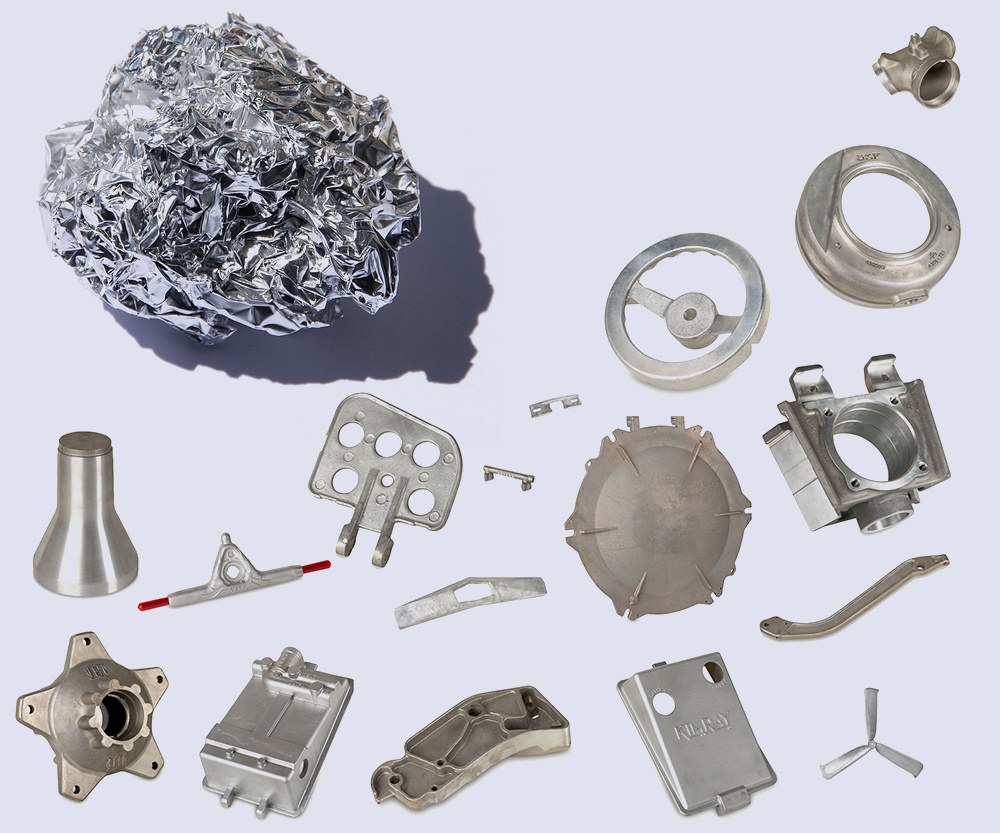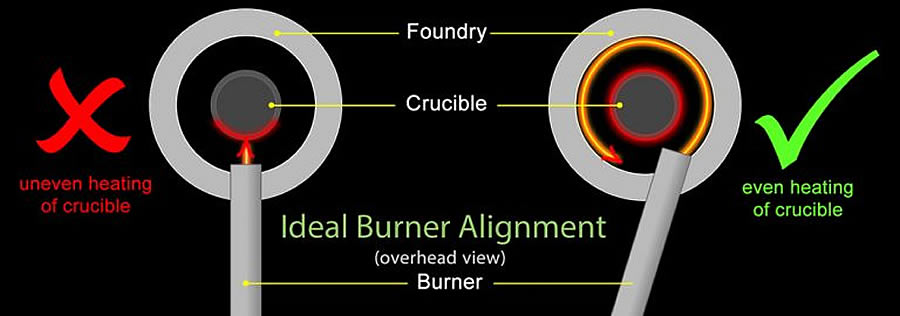How Aluminum Foundry Wisconsin strengthens casting businesses
Wiki Article
Exactly How Aluminum Foundry Contributes to Improvements in Aerospace Design
Aluminum shops are important to innovations in aerospace design. They produce light-weight, high-strength parts that are vital for contemporary airplane. With sophisticated spreading strategies, these foundries create intricate geometries that boost structural stability. In addition, the advancement of superior Aluminum alloys sustains the market's concentrate on fuel performance and sustainability. Obstacles continue to be in the manufacturing process. Recognizing these factors discloses the profound impact of Aluminum on air travel's future.The Importance of Lightweight Products in Aerospace Design
As the aerospace sector proceeds to evolve, the importance of lightweight products ends up being progressively obvious. The demand for effectiveness and sustainability drives engineers to prioritize using materials that reduce general weight without compromising structural integrity. Light-weight materials, specifically Aluminum, play a crucial duty in enhancing fuel effectiveness, boosting payload capacity, and enhancing the overall performance of aircraft.The assimilation of these materials enables for innovative designs, allowing suppliers to produce even more wind resistant shapes that can endure severe conditions. The decrease in weight not only reduces functional prices however likewise adds to a lowered environmental impact, aligning with worldwide efforts towards sustainability in aviation.
Advanced Spreading Techniques in Aluminum Foundries
Advanced spreading methods in Aluminum shops play an essential role in aerospace design by allowing the production of light-weight and precise elements. Advancements in mold and mildew design and accuracy spreading procedures are necessary in attaining optimal performance and structural honesty. Furthermore, the development of lightweight alloys enhances the overall effectiveness and efficiency of aerospace applications.Innovative Mold And Mildew Layout
Ingenious mold and mildew design plays a vital duty in the effectiveness and efficiency of Aluminum shops, specifically within the aerospace industry. By leveraging advanced materials and strategies, contemporary mold and mildews can be engineered to stand up to high temperature levels and stress, making sure peak performance during the casting process. These layouts commonly include complicated geometries that enable the manufacturing of lightweight yet structurally audio parts, crucial for aerospace applications. Additionally, using computer-aided style (CAD) software application helps with precise modeling, enabling shops to fine-tune and simulate mold styles prior to physical production starts. This not only enhances the quality of cast components yet also decreases waste and preparation, resulting in substantial expense savings. On the whole, cutting-edge mold and mildew style is a cornerstone of progress in Aluminum Foundry modern technology for aerospace engineering.Accuracy Casting Procedures
The performance of ingenious mold and mildew designs perfectly integrates with precision casting procedures, which are essential for generating top notch Aluminum parts in aerospace design. These processes, including sand spreading, die casting, and financial investment casting, assure the development of complex geometries with limited tolerances. Advanced methods like vacuum spreading and stress pass away casting improve the integrity and surface coating of the end products. Precision casting lessens product waste while optimizing the mechanical residential or commercial properties of Aluminum, important for aerospace applications. Furthermore, employing real-time tracking and advanced simulation devices during the casting process permits immediate modifications, resulting in boosted quality assurance. Collectively, these accuracy casting processes position Aluminum foundries at the leading edge of aerospace development, supporting the market's demand for dependability and performance.Light-weight Alloy Development
As aerospace engineers look for to boost fuel efficiency and performance, lightweight alloy growth comes to be an essential emphasis in Aluminum shops. These factories employ sophisticated casting strategies to develop alloys that provide superior strength-to-weight proportions. Innovations in alloy composition, consisting of the consolidation of elements like lithium and magnesium, enable the manufacturing of materials that endure severe problems while decreasing overall airplane weight. Methods such as die casting and investment spreading promote the accuracy production of intricate shapes, which are crucial for aerospace applications. In addition, ongoing research study aims to optimize these alloys for enhanced mechanical homes and boosted toughness. By prioritizing lightweight alloy growth, Aluminum shops substantially add to the advancement of aerospace engineering, leading the way for much more effective and sustainable aircraft layouts.
Enhancing Architectural Honesty With Aluminum Components
Aluminum elements use significant benefits in improving architectural stability within aerospace design. Their light-weight nature contributes to overall effectiveness while preserving strength, which is necessary for aircraft efficiency. In addition, the stress and anxiety resistance properties of Aluminum assistance guarantee the resilience and reliability of aerospace structures under various functional problems.
Lightweight Product Perks
While conventional products typically jeopardize weight for stamina, making use of Aluminum elements in aerospace engineering uses substantial benefits in architectural integrity. Aluminum's lightweight nature adds to total design performance, permitting even more streamlined aircraft that consume much less gas, thereby improving sustainability. The material's superb strength-to-weight proportion assurances that parts keep resilience without adding unnecessary mass. This high quality fosters improved performance and agility in trip, as well as optimized haul capacities. Additionally, Aluminum's resistance to corrosion prolongs the lifespan of aerospace structures, decreasing maintenance expenses and boosting security. As producers progressively embrace Aluminum alloys, the aerospace industry experiences a transformative shift in the direction of more efficient and effective design services that focus on both efficiency and ecological duty.Stress And Anxiety Resistance Properties
Although numerous products possess special residential or commercial properties, Aluminum's exceptional tension resistance stands apart as an important factor in boosting the architectural honesty of aerospace elements. This resistance plays an important duty in making certain that airplane can stand up to different operational stresses, including fatigue, impact, and environmental conditions. Aluminum alloys, specifically engineered for aerospace applications, display high tensile stamina while preserving lightweight attributes, enabling designers to develop much more effective structures - Aluminum Foundry. Furthermore, the capability of Aluminum to sustain cyclic loading without significant contortion adds to the longevity and reliability of aerospace components. As innovations proceed in Aluminum Foundry Wisconsin Aluminum Foundry strategies, the advancement of stress-resistant Aluminum elements assures more renovations in performance, security, and performance throughout the aerospace industry, strengthening Aluminum's role as a recommended material in modern designGas Performance Improvements Driven by Aluminum Innovations
As the aerospace industry seeks to enhance gas performance, ingenious usages of Aluminum have emerged as an important solution. Aluminum's light-weight nature notably reduces aircraft weight, permitting for lower gas usage during flight. This decrease in weight is crucial, as also tiny decreases can bring about significant renovations in total gas economy.Advanced Aluminum alloys, created for boosted stamina and sturdiness, make it possible for makers to create components that keep architectural integrity while reducing mass - Aluminum Foundry. In addition, the integration of Aluminum in airframes and engine elements promotes enhanced the rules of aerodynamics, contributing to lowered drag and raised performance
The adoption of Aluminum in aerospace not just fulfills the need for fuel-efficient design yet likewise aligns with governing stress for reduced exhausts. As these advancements remain to advance, they play a significant role in setting new standards for gas efficiency, ensuring that the aerospace industry can fulfill expanding economic and environmental difficulties.

The Duty of Aluminum in Sustainable Air Travel Practices
The enhancing emphasis on sustainable air travel techniques has actually placed Aluminum as a necessary product in the pursuit for greener airplane layout. Understood for its lightweight buildings, Aluminum substantially decreases aircraft weight, causing lower gas usage and exhausts. Its recyclability additionally improves its sustainability account, as Aluminum can be recycled forever without loss of quality. This characteristic sustains a round economic situation within the air travel sector, reducing waste and resource depletion.Furthermore, developments in Aluminum alloys have actually boosted their toughness and corrosion resistance, permitting longer service life and lowered maintenance demands. These advancements promote the advancement of much more effective aircraft structures, adding to overall sustainability initiatives. Furthermore, Aluminum's thermal conductivity plays an important role in energy-efficient layouts, boosting systems such as heat exchangers. Collectively, these characteristics highlight Aluminum's pivotal function ahead of time lasting aeronautics, lining up with international campaigns intended at reducing the environmental effect of air travel.
Obstacles Faced by Aluminum Foundries in Aerospace Manufacturing
While Aluminum factories play a crucial role in aerospace manufacturing, they encounter substantial challenges that can influence production efficiency and high quality. One significant obstacle is the rigorous quality assurance requirements required in the aerospace industry. Any type of problem can compromise security and efficiency, necessitating extensive examination procedures that extend production timelines. Furthermore, shops typically contend with fluctuating resources expenses, which can affect pricing and earnings. The intricacy of Aluminum alloys utilized in aerospace applications more complicates the production procedure, as accurate formulations are essential for accomplishing wanted mechanical buildings. Proficient labor shortages hinder the capacity to preserve top notch production degrees. Ultimately, ecological policies enforce restrictions on emissions and waste management, requiring foundries to buy lasting methods, which can be cost-prohibitive. These factors jointly produce a landscape where Aluminum shops need to continually adjust to fulfill the developing needs of aerospace manufacturing while ensuring safety and security and conformity.Future Trends in Aluminum Applications for Aerospace Design
With developments in modern technology and raising demands for performance, the future of Aluminum applications in aerospace design is positioned for substantial improvement. The assimilation of innovative Aluminum alloys and compounds is expected to improve strength-to-weight proportions, causing even more fuel-efficient airplane styles. Additionally, advancements in additive production methods will permit the manufacturing of complicated Aluminum frameworks that were formerly impossible, optimizing efficiency and decreasing waste.
Lasting practices will play an important role, with an expanding focus on reusing Aluminum to minimize environmental influence. The aerospace field is likely to accept smarter producing procedures, such as automation and artificial intelligence, making sure better and accuracy in Aluminum parts. Partnerships in between Aluminum factories and aerospace companies will certainly promote research study and advancement, leading the way for brand-new applications that meet the strict needs of contemporary aerospace design. Overall, the future looks guaranteeing for Aluminum's function fit the skies
Frequently Asked Questions
What Are the Ecological Effects of Aluminum Production in Aerospace?
The environmental impacts of Aluminum production in aerospace consist of considerable energy consumption, greenhouse gas discharges, and environment disruption. Furthermore, mining procedures can bring about soil destruction and water contamination, raising issues concerning sustainability and eco-friendly balance.Just How Does Aluminum Compare to Other Products in Aerospace Applications?
Aluminum uses a special combination of light-weight buildings, deterioration resistance, and cost-effectiveness compared to various other products. Its high strength-to-weight proportion makes it specifically advantageous for aerospace applications, improving gas performance and general performance in aircraft layout.What Credentials Do Aluminum Foundry Workers Demand for Aerospace Projects?
Aluminum Foundry workers need specific training in metallurgy and spreading techniques, along with understanding of aerospace sector criteria. Qualifications in quality assurance and safety protocols are also vital to assure conformity with rigid aerospace project demands.Exist Any Type Of Safety And Security Worry About Making Use Of Aluminum in Aerospace Engineering?
Safety problems concerning Aluminum in aerospace engineering include vulnerability to fatigue, corrosion, and tension cracks. Correct therapy and alloy selection are crucial to alleviate these dangers, making certain structural integrity and overall safety in aerospace applications.Just How Does Aluminum Recycling Benefit the Aerospace Sector?
Aluminum reusing significantly profits the aerospace sector by decreasing material costs, minimizing ecological effect, and conserving energy. This lasting method enhances the market's efficiency while promoting the usage of light-weight, high-performance elements in aircraft manufacturing.Advanced spreading strategies in Aluminum foundries play a vital role in aerospace design by making it possible for the manufacturing of exact and lightweight elements. Ingenious mold and mildew layout plays an important role in the performance and performance of Aluminum factories, specifically within the aerospace field. As aerospace engineers look for to improve gas performance and efficiency, light-weight alloy development comes to be a necessary emphasis in Aluminum foundries. Aluminum alloys, especially crafted for aerospace applications, exhibit high tensile strength while keeping lightweight characteristics, making it possible for engineers to design extra reliable structures. Partnerships in between Aluminum foundries and aerospace business will certainly promote research study and advancement, paving the means for brand-new applications that fulfill the rigid needs of contemporary aerospace engineering.
Report this wiki page